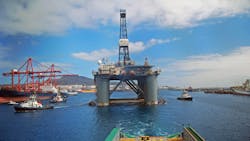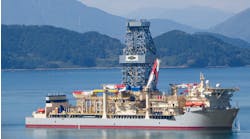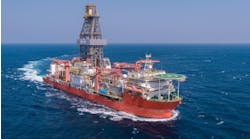Editor's note: This Vessels/Rigs column first appeared in the March-April issue of Offshore magazine. Click here to view the full issue.
By Bruce Beaubouef, Houston
The rig market is showing signs of tightening as dayrates remain high, scrapping has declined precipitously, and some operators are even pausing their drilling campaigns as inventories become lean.
The industry is now once again amid a rig market upcycle that has been ongoing since the latter half of 2021, with higher demand and utilization now being recorded in all three offshore drilling rig segments.
Noble Corp. recently reported that its marketed fleet of 16 floating drilling rigs was 91% booked during 4Q 2022. This included seven ultradeepwater rigs added following the merger with Maersk Drilling.
Tier 1 drillships area commanding increased day rates, the company said, currently in the low to mid $400,000s per day range. And since early November, Noble has secured 24 months of additional work for four sixth-generation and seventh-generation drillships at an average rate above $420,000 per day.
As for the company’s 13 jackups, utilization was 85% in the fourth quarter, and included 10 that were part of the Maersk fleet. Nine of the 13 jackups are contracted, with an overall $1 billion jackup backlog that is heavily weighted to the commitments of Noble Integrator and Noble Invincible under the Aker BP alliance in Norwegian waters.
Meanwhile, offshore rig scrapping is at its lowest in years as the recovery intensifies. As reported by Teresa Wilkie of Westwood Global Energy Group, no drillships were removed from the active fleet in 2022, while just nine jackups and six semis were retired, the majority of which were over 30 years old.
“This indicates that rig owners are hanging on to vintage or cold-stacked tonnage, as is generally the case in a rising rig demand and day rate market,” Wilkie wrote. “However, the available supply of active (non-cold stacked) rigs, especially jackups and drillships, is shrinking fast and there has already been word that several rigs, which have been idle for multiple years, are being bid into tenders where rig owners do not have any active rigs to bid.” Wilkie also said that “it is understood that a driller may now have to wait as long as 18 months for a reactivation to be completed these days.”
As the supply/demand balance tightens, the reactivation of rigs has been on the rise with approximately 25 jackups, three semis and nine drillships brought back to life since 2021, according to Westwood RigLogix.
The level of newbuilds being delivered from shipyards has not increased to the same level witnessed during the short-lived 2019 recovery period. Most of the remaining stranded newbuild rigs available, of which there are 22 jackups, 15 drillships and eight semis, are owned by the shipyards “and drilling contractors continue to be very cautious when it comes to purchasing such a rig,” said Wilkie. “However, 2023 could be the year the tide turns on this, especially if the level of demand continues to improve.” In the last quarter of 2022, Transocean announced that it had signed a purchase agreement as part of a joint venture for the seventh-generation ex-West Aquila drillship for $200 million from the Daewoo shipyard. Meanwhile, Saipem confirmed it had exercised its option to buy the seventh-generation Santorini drillship (originally ordered by Ocean Rig), which it had been bare-boat chartering from Samsung Heavy Industries since 2021. “Meanwhile, it’s understood that various drilling contractors are eyeing the remaining drillships left in yards,” Wilkie added.
In fact, the growing tightness of the rig market may even be leading to a short-term pause in drilling contracting activity, according to recent analysis from Evercore ISI. The firm recently reported that drilling contracting activity had slowed in March with only a few contracts announced halfway through the month. This follows a busy February where five drillships and four jackups secured new multi-year terms.
With all available sixth and seventh-generation drillships spoken for and only eight floaters rolling off contract over the next few months, “contracting activity is likely to remain limited in the near term,” the firm commented. “Meanwhile we count 14 cold stacked and 12 newbuild drillships available, of which seven are scheduled [to be] delivered this year,” Evercore said in its latest Offshore Rig Market Snapshot. This includes the 99% finished seventh-generation CAN-DO, the lone Singapore-based drillship transferred to Rigco Holding Pte Ltd following the merger of Keppel and Sembcorp Marine; and the reportedly 74% completed Guarapari, one of four remaining floaters originally ordered for Sete Brasil.
“We believe [that] four or five newbuild drillships from the South Korean yards are more likely to be delivered, including the Valaris DS-13 and Transocean’s Deepwater Aquila from DSME; and the Stena Evolution (former Ocean Rig Crete) and Dorado from Samsung,” the firm noted.




